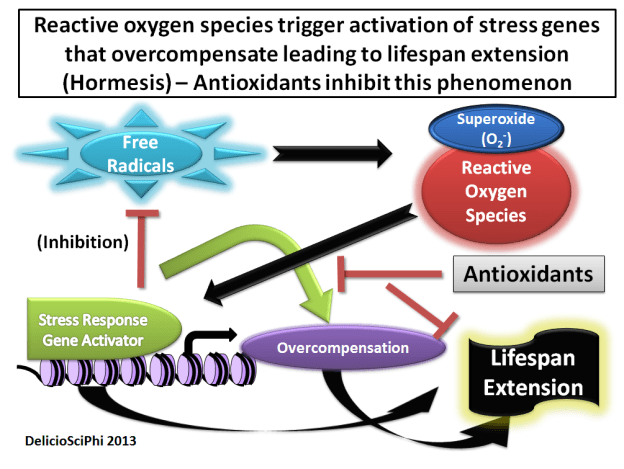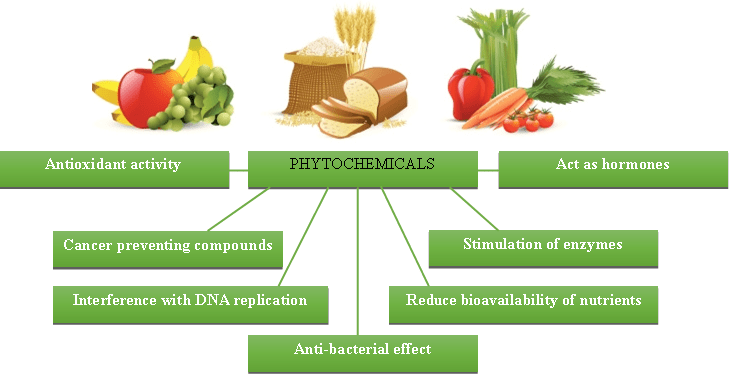Key Difference – Antioxidants vs Phytochemicals
Let us first understand the two terms Antioxidants and Phytochemicals before moving on to the discussion of the difference between Antioxidants and Phytochemicals. Antioxidants are natural or synthetic chemical constituents that protect human cells from the harmful effects of free radicals. Phytochemicals are natural chemical constituents derived from plants that provide various health benefits for humans. The key difference between antioxidants and phytochemicals is that the main function of antioxidants is to destroy or quench free radicals in the cellular environment whereas phytochemicals have various functions including preventing the action of free radicals, stimulation of enzymes, interference with DNA replication etc.Although these two classes of chemical substances overlap in some areas, there are significant differences between antioxidants and phytochemicals. Thus, the purpose of this article is to highlight the differences between antioxidants and phytochemicals.
What are Antioxidants?
Antioxidants can prevent the action free radicals. Thus, they can help prevent cardiovascular disease, diabetes, cancer, and conditions associated with aging (Parkinson’s disease and Alzheimer’s disease). Free radicals are highly reactive atoms or groups of atoms because they have at least one unpaired electron. Free radicals produce harmful oxidation also known as oxidative stress that can damage cell membranes and cellular contents. Oxidative stress or excessive generation of free radicals in the cellular environment occurs naturally as well as when you are exposed to detrimental environmental factors such as radiation or tobacco smoke. In some occasions, free radicals encourage beneficial oxidation that produces energy and kills harmful bacteria. As the name ‘antioxidants’ suggest, they prevent or reduce this oxidative stress and can inhibit oxidative damage to cellular components such as DNA, proteins, and lipids. These antioxidant compounds can be derived from both animal and plant food sources. Examples of antioxidant substances include phenolic compounds, anthocyanin, vitamins A, C and E, lutein, lycopene, beta-carotene, coenzyme Q10, butylated hydroxyanisole, flavonoids, and free fatty acids.
What are Phytochemicals?
Phytochemicals are chemical combinations that occur naturally in different plant species. Phyto means “plant” in the Greek language. Each and every plant contains hundreds of phytochemicals and research evidence exists that these phytochemicals can help prevent many non-communicable diseases. Phytochemicals are found in plant materials such as fruits, vegetables, nuts, spices, cereals, legumes, grains, and beans. Examples of phytochemicals include groups of substances such as anthocyanin, polyphenols, phytic acid, oxalic acid, lignans, and isoflavones, as well as folic acid and vitamin C, vitamin E, and beta-carotene (or pro-vitamin A). Some phytochemicals are responsible for color and other organoleptic properties, such as the orange color of carrots and the smell of cinnamon respectively. Although they may have biological significance, they are not recognized as essential nutrients. Phytochemicals have protective or disease preventive characteristics. Each and every phytochemical function differently, and these are some possible functions:

What is the difference between Antioxidants and Phytochemicals?
Definition of Antioxidants and Phytochemicals
Antioxidants: Antioxidants are Chemical compounds that can combat oxidation.
Phytochemicals: Phyto means “plant” in Greek. Thus, phytochemicals are chemical combinations that occur naturally in plant species.
Characteristics of Antioxidants and Phytochemicals
Source
Antioxidants: Antioxidants can be obtained from both plant and animal foods.
Phytochemicals: phytochemicals are only originated in plant sources such as vegetables, fruits, grains, beans, nuts, and seeds.
Function
Antioxidants: Antioxidants help prevent damage to cells from highly reactive and unstable free radicals.
Phytochemicals: Phytochemicals have multiple functions.
Detrimental Effect
Antioxidants: Antioxidants considered as good for health.
Phytochemicals: Phytochemicals can act as anti-nutritional compounds and reduce the bioavailability of nutrients. Thus, they are not always good for health and wellbeing. Eg: Phytic acid, Oxalic acid.
E-numbers
Antioxidants: E-numbers of antioxidants range from E300–E399. Examples of natural antioxidants are ascorbic acid (E300) and tocopherols (E306). Synthetic antioxidants include propyl gallate (PG, E310), tertiary butylhydroquinone (TBHQ), butylated hydroxyanisole (BHA, E320) and butylated hydroxytoluene (BHT, E321).
Phytochemicals: Phytochemicals do not have specific E-number range because some phytochemicals act as antioxidants (E300–E399), some act as coloring compounds (E100–E199), etc.
Industrial Application
Antioxidants: Antioxidants are used as preservatives in food and cosmetics. These preservatives include natural antioxidants such as ascorbic acid, tocopherols, propyl gallate, tertiary butyl hydroquinone, butylated hydroxyanisole and butylated hydroxytoluene. In addition to that, antioxidants are frequently added to industrial non-food products. It is used as stabilizers in fuels and lubricants to inhibit oxidation, in gasoline to inhibit the polymerization that leads to the development of engine-fouling residues and to prevent the degradation of rubber and gasoline.
Phytochemicals: Phytochemicals are widely used as dietary supplements (functional foods, nutraceuticals) for the prevention of non-communicable diseases.
Method of Analysis
Antioxidants: Antioxidant content is usually analyzed using a powerful radical or identifying the reducing ability. Examples are DPPH radical scavenging method, Hydroxyl radical scavenging activity, oxygen radical absorbance capacity (ORAC), ABTS radical scavenging method or ferric reducing activity or FRAF assay.
Phytochemicals: Phytochemicals are analyzed using a standard phytochemical. For example, total phenolic content is analyzed using Folin-Ciocalteu colorimetric method with the help of standard phenolic compound known as Gallic acid.
Degradation
Antioxidants: Antioxidants are highly susceptible to degradation when they expose to oxygen, sunlight, temperature, etc. As examples vitamins A, C or E antioxidants can be destroyed by long-term storage or prolonged cooking of vegetables.
Phytochemicals: Compared to antioxidants, phytochemicals (without having antioxidant activity) can withstand somewhat to advance environmental factors.
Examples
Antioxidants: Selenium (Broccoli, cauliflower), allyl sulfides (onions, leeks, garlic), carotenoids (fruits, carrots), flavonoids (cauliflower, Brussels sprouts, grapes, radishes and red cabbage), polyphenols (tea, grapes), vitamin C (amla, guava, yellow color vegetables), vitamin A, vitamin E, Fatty acids (Fish, meat, sea foods), lecithin (egg)
Phytochemicals: Isoflavones and lignans (soy, red clover, whole grains and flaxseed), Selenium (Broccoli, cauliflower), allyl sulfides (onions, leeks, garlic), carotenoids (fruits, carrots), flavonoids (cauliflower, Brussels sprouts, grapes, radishes and red cabbage), polyphenols (tea, grapes), vitamin C (amla, guava, yellow color vegetables), vitamin A, vitamin E, Fatty acids (Fish, meat, sea foods), lecithin (egg), Indoles (cabbages), terpenes (citrus fruits and cherries).
In conclusion, although several phytochemicals work as antioxidants to promote good health, many of them have extra functions. It is known that people who eat adequate amounts of fruits and vegetables high in a full spectrum of health-protective antioxidants and phytochemicals have a lower incidence of non-communicable diseases.
References: Sies, H. (1997). Oxidative stress: oxidants and antioxidants. Experimental Physiology, 82(2): 291–5. Smirnoff, N. (2001). L-ascorbic acid biosynthesis. Vitamins and Hormones. 61:241–66. Padayatty, S. J., Katz, A., Wang, Y., Eck, P., Kwon, O., Lee, J.H., Chen, S., Corpe, C., Dutta, A., Dutta, S. K., Levine, M. (2003). Vitamin C as an antioxidant: evaluation of its role in disease prevention. Journal of the American College of Nutrition, 22(1):18–35. Fruits and Veggies, More Matters. What are phytochemicals? Produce for Better Health Foundation. (2014). Retrieved 18 June 2014. Image Courtsey: “Free Radicals need a PR firm- Hormesis + Longevity” by deliciosciphi (CC BY 3.0) via deliciosciphi.deviantart.comncG1vNJzZmivp6x7pbXFn5yrnZ6YsqOx07CcnqZemLyue8OinZ%2Bdopq7pLGMm5ytr5Wau26tza2gqLCZma6vwNJmmKecXavAbrzHsquom5iauqqvwKWqaA%3D%3D